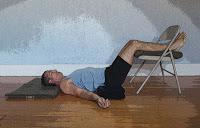Last week in my posts about anxiety Anxiety, Yoga and the Front Body and Soothing Yourself With Supported Forward Bends, I discussed yoga poses to rely on when you’re feeling anxious (supported inversions and forward bends) and yoga poses to avoid when you’re in that state (backbends, twists, and Sun Salutations).
It makes sense if you’re in a crisis period to practice the poses that calm you down and avoid stimulating poses that might exacerbate your condition. However, if you’re in a state of chronic anxiety, avoiding backbends, twists, and many of the active poses for a long period of time will move your body toward imbalance. The same is true if your practice is focused on any emotion-based condition, such as agitated depression, clinical depression, or even just chronic stress.
In this case, I feel it is better to return to a more well-rounded yoga practice (see A Week of Yoga Practice) but consider how you end your practices. By choosing an appropriate counter-pose to end your practice, you can counteract any negative emotional effects of your practice without negating the beneficial physical ones. That way, you can move on to the rest of your day with your nervous system and emotions more in balance. Some people with anxiety or agitated depression even find that beginning with a very active practice can help burn off excess energy, which makes the soothing or relaxing counter-poses at the end of the sequence more effective (or even possible, as it can be hard to stay still when you’re feeling very anxious).
My post Yoga and Your Emotions describes the emotional effects different types of poses have on most people. So if you’re interested in practicing for balancing your emotions, take a look at that and consider how a given practice (standing pose, Sun Salutation, twist, backbend, forward bend, restorative) might affect your current emotional state. Then choose one or more counter-poses—especially passive poses that can be held for long periods of time—that you can add on to the end of your practice to counteract the poses that were the main focus of the practice. For example, if you’re already feeling anxious or hyper yet need to practice backbends for the health of your body, you can end your backbend sequence with a long supported inversion, such as a Chair Shoulderstand or Legs Up the Wall pose, to calm yourself down.
 Anxiety and Agitated Depression. We’ve already said that supported inverted poses and supported forward bends are the best poses to counteract anxiety. These may also be helpful for agitated depression as that is anxiety based. So at the end of a more active sequence, try resting in Supported Child’s pose for a few minutes and then practice Legs Up the Wall pose (Viparita Karani) for 10 minutes or more. If Child’s pose is uncomfortable for you or you can’t kneel for some reason, try a Supported Seated Forward Bend with a chair (see Soothing Yourself With Supported Forward Bends), with a straight back. If Legs Up the Wall pose doesn’t work well for you, try Easy Inverted Pose (Featured Pose: Easy Inverted Pose). If having your front body exposed makes you feel vulnerable, try covering yourself with a blanket.
Anxiety and Agitated Depression. We’ve already said that supported inverted poses and supported forward bends are the best poses to counteract anxiety. These may also be helpful for agitated depression as that is anxiety based. So at the end of a more active sequence, try resting in Supported Child’s pose for a few minutes and then practice Legs Up the Wall pose (Viparita Karani) for 10 minutes or more. If Child’s pose is uncomfortable for you or you can’t kneel for some reason, try a Supported Seated Forward Bend with a chair (see Soothing Yourself With Supported Forward Bends), with a straight back. If Legs Up the Wall pose doesn’t work well for you, try Easy Inverted Pose (Featured Pose: Easy Inverted Pose). If having your front body exposed makes you feel vulnerable, try covering yourself with a blanket.  Clinical Depression. On the other hand, for people who are suffering from clinical depression, forward bends, with their inward turning quality, can cause you to brood. For you, therefore, a couple of mild, active backbends, such as Purvottanasana (Reverse Plank pose) or Bridge pose, would be good counter poses after practicing a forward bend sequence. Generally speaking, an active practice is best for those with clinical depression, especially one that includes backbends, because that helps counteract feelings of lethargy. But if you are tired and want to practice restorative poses, focus on passive backbends rather than forward bending poses, and be sure to end your sequence with a backbending position, rather than a forward bending one. Rather than doing Savasana flat on your back, try doing it with your torso supported by a bolster or stack of blankets, so your chest is open and your back is in a slight backbend. Or, maybe even reverse the typical pattern of a practice, begin your sequence with resting poses and moving slowly onto more active ones so you are left feeling a bit energized. Often I'll end a restorative sequence by standing in Mountain pose and inhaling as I raise my arms overhead into a slight backbend and exhaling as I return my arms to my sides.
Clinical Depression. On the other hand, for people who are suffering from clinical depression, forward bends, with their inward turning quality, can cause you to brood. For you, therefore, a couple of mild, active backbends, such as Purvottanasana (Reverse Plank pose) or Bridge pose, would be good counter poses after practicing a forward bend sequence. Generally speaking, an active practice is best for those with clinical depression, especially one that includes backbends, because that helps counteract feelings of lethargy. But if you are tired and want to practice restorative poses, focus on passive backbends rather than forward bending poses, and be sure to end your sequence with a backbending position, rather than a forward bending one. Rather than doing Savasana flat on your back, try doing it with your torso supported by a bolster or stack of blankets, so your chest is open and your back is in a slight backbend. Or, maybe even reverse the typical pattern of a practice, begin your sequence with resting poses and moving slowly onto more active ones so you are left feeling a bit energized. Often I'll end a restorative sequence by standing in Mountain pose and inhaling as I raise my arms overhead into a slight backbend and exhaling as I return my arms to my sides.  Stress. For people who are suffering from chronic stress, standing poses, Sun Salutations, backbends, and twists can be over stimulating. So try to end a sequence that is focused on any of those types of poses with any long supported inversion, such as Legs Up the Wall pose or Easy Inverted pose, or any restorative pose that you enjoy.
Stress. For people who are suffering from chronic stress, standing poses, Sun Salutations, backbends, and twists can be over stimulating. So try to end a sequence that is focused on any of those types of poses with any long supported inversion, such as Legs Up the Wall pose or Easy Inverted pose, or any restorative pose that you enjoy.Even a long Savasana of 10 minutes or more, with a mental focus, such as your breath, would be helpful as an emotional counter-pose (see Savasana Variations) or any form of yoga nidra (see Audio Tracks tab above). Stressed out people tend to skip these ending poses because they think they don’t have time and that restorative poses are not “productive.” However, when you’re suffering from chronic stress, the most beneficial practice for you is some type of conscious relaxation (see The Relaxation Response and Yoga). As with anxiety, you may need to first burn off excess energy with a more active practice, but always leave time for conscious relaxation at the end of your sequence.
 I, myself, have been practicing like this for many years, with focused, nervous-system pacifying sequences during particularly challenging times, and balanced sequences with emotional counter-poses the rest of the time. But what if you, like many other people, do not practice often at home and do most of your yoga practice in classes or with videos? In this case, there is no reason why you can’t do just the counter-pose after the class or video. For example, if an evening backbend practice has left you feeling agitated or even just hyper (I can’t tell you how many people have told me that backbends at night cause insomnia), there’s no reason why you can’t just practice a supported inverted pose or conscious relaxation on your own before bed. This will help pacify your nervous system and may even lead to better sleep.
I, myself, have been practicing like this for many years, with focused, nervous-system pacifying sequences during particularly challenging times, and balanced sequences with emotional counter-poses the rest of the time. But what if you, like many other people, do not practice often at home and do most of your yoga practice in classes or with videos? In this case, there is no reason why you can’t do just the counter-pose after the class or video. For example, if an evening backbend practice has left you feeling agitated or even just hyper (I can’t tell you how many people have told me that backbends at night cause insomnia), there’s no reason why you can’t just practice a supported inverted pose or conscious relaxation on your own before bed. This will help pacify your nervous system and may even lead to better sleep.

